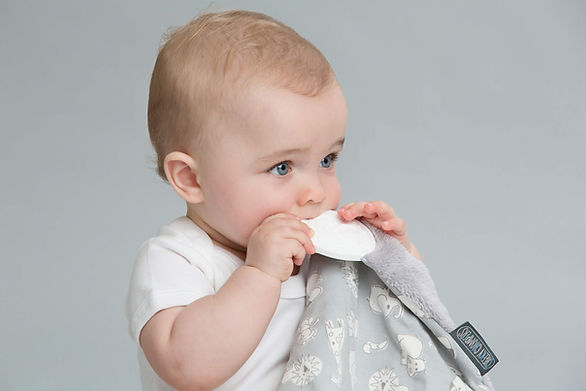This blog post is about the symptoms of teething.

This site contains affiliate links; please view the disclosure for more information.
Symptoms of Teething and Soothing Solutions for Relief
Teething is a major milestone in a baby’s life, but it can be a challenging time for both the little one and their parents. As those tiny teeth start to emerge, understanding the signs can help parents provide the right comfort and care. This blog post will get into the common symptoms of teething, offering insights and tips to help your baby through this natural, yet sometimes uncomfortable, process. From drooling to irritability, we’ll cover the key signs that indicate your baby is teething and how to soothe their discomfort.
Teething typically starts around 6 months of age, but it’s not uncommon for it to begin as early as 3 months or as late as 12 months. Every baby is different, and the timing can vary widely. Most babies have their first tooth appear by the time they turn one year old. The top front teeth, also referred to as the upper central incisors, typically erupt second, after the lower front teeth, also known as the lower central incisors.
During this period, parents might notice their baby showing more interest in chewing on objects or increased drooling. It’s a natural process where the baby’s teeth gradually make their way through the gums. This can be a period of discomfort for some babies, while others might not seem bothered at all.

28 Symptoms of Teething that Babies May Experience
Drooling: Increased saliva production is common as teething stimulates drool.
Gum Swelling and Tenderness: Gums may become swollen and tender as teeth push through.
Biting Behavior: Babies often bite on toys, fingers, or other objects to relieve pressure on their gums.
Irritability: Discomfort from teething can make babies fussier than usual.
Decreased Appetite: Pain and discomfort might reduce their interest in eating.
Rubbing Face and Ears: Babies may rub their face or ears due to referred pain from teething.
Slight Fever: Your baby’s temperature may rise slightly, but a high fever is not a normal sign of teething and should be checked out by a doctor.
Difficulty Sleeping: Discomfort can disrupt normal sleep patterns.
Increased Night Waking: Teething pain may cause babies to wake up more often during the night.
Coughing: Excess drool can cause coughing or gagging.
Cheek Rubbing: Similar to rubbing ears, they might rub their cheeks due to pain.
Diarrhea: Some believe teething can cause loose stools, but this is controversial and not scientifically proven.
Nappy Rash: Increased drooling can lead to more acidic stools, potentially causing diaper rash.
Cold-Like Symptoms: Sniffles and a runny nose can accompany teething, though they’re not directly caused by it.
Chin or Facial Rash: Drool can irritate the skin, leading to rashes around the mouth and chin.
Teething Symptoms
Pulling on Ears: Babies might pull on their ears due to the pain radiating from the jaw.
Increased Need for Sucking: Sucking on pacifiers or fingers can provide relief.
Chewing on Solid Objects: The urge to chew on hard objects helps counter the pressure from under the gums.
Bulging Gums: A bluish bulge in the gum is often a sign that a tooth is about to emerge.
Refusal of Food or Bottle: Babies might refuse to eat or drink due to mouth soreness.
Decreased Breastfeeding: Nursing babies might breastfeed less often or for shorter durations.
Clutching the Mouth: Older babies might try to reach into their mouths to soothe the discomfort.
General Discomfort: A general sense of unease and discomfort is common.
Decreased Solid Food Intake: Babies who have started solids might eat less during teething.
Flushed Cheeks: One or both cheeks might appear flushed due to inflammation.
White Spots on Gums: These spots might indicate where a tooth is about to break through.
Slight Increase in Diaper Output: The excess drooling can lead to a slight increase in wet diapers.
Changes in Stool Consistency: While not scientifically proven, some parents report a change in their baby’s stool consistency during teething.
Soothing Solutions for Teething Babies

When it comes to soothing a teething baby, there are several effective and safe methods parents can use to ease their little one’s discomfort. Here are some tried-and-true solutions:
- Teething Rings and Toys: Soft, chewable teething rings or toys can be very comforting. Look for ones that can be chilled in the refrigerator. The coolness can help numb the gums and reduce swelling. Avoid freezing them, as this can make them too hard and could hurt your baby’s gums.
- Gentle Gum Massage: Clean fingers or a soft, wet cloth can be used to gently rub your baby’s gums. The pressure can provide relief from the pain. Make sure your hands are clean before doing this to prevent the spread of bacteria.
- Cold Food and Drinks: If your baby is already eating solid foods, cold items like yogurt, refrigerated fruit purées, or even a cold spoon can help soothe their gums. Always supervise your baby while they eat to prevent choking.
- Pain Relief Medication: If your baby seems particularly uncomfortable, you might consider using over-the-counter pain relief medications specifically designed for babies, like acetaminophen or ibuprofen. Always follow the dosage instructions and consult with your pediatrician before administering any medication.
- Comfort and Distraction: Sometimes, the best remedy is extra cuddles, gentle rocking, or a little extra attention. Distracting your baby with new toys or activities can also take their mind off the discomfort.
- Avoid Teething Gels with Benzocaine: The FDA advises against using teething creams or gels with benzocaine in children under two years old, as they can cause harmful side effects.

Final Thoughts
While teething is a normal part of a baby’s growth and development, it can be hard at times. Being aware of the symptoms and having a toolbox of soothing solutions can make this phase more comfortable for both you and your baby. With patience, understanding, and a little bit of trial and error, you’ll find the best ways to support your little one through their teething journey.



